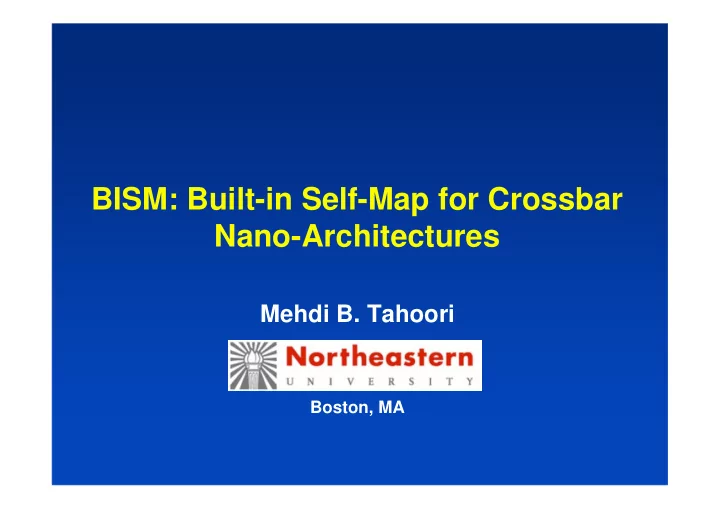

BISM: Built-in Self-Map for Crossbar Nano-Architectures Mehdi B. Tahoori Boston, MA
Outline • Introduction • Bottom-up Self-Assembly • Crossbar Nano-architectures • Built-in Self-Map – Various Schemes and Comparisons • Conclusions
Bottom-Up Fabrication Bottom-Up Fabrication • Use bottom-up assembly as an alternative to top-down – Rely on self-assembly for defining device characteristics – Easier (less costly) fabrication process – Requires fabrication regularity • Lends itself more easily to a reconfigurable architecture BUT… • This creates new challenges: – Can no longer arbitrarily determine device/wire placement. • Leads to higher defect rates – Fabrication may be restricted to simpler (less robust) structures • e.g., 2-terminal vs. 3-terminal devices
Molecular Crossbar • Building Block for crossbar array architectures – Fabricated by chemical self-assembly process • Two layers of orthogonal nanowires/CNTs – Programmable switch at each crosspoint • Rotaxane molecule • Located at each intersection of wires • Determine the configuration of the crossbar • Can be used for bist able junct ion – Signal routing – logic – Memory
Application-Dependent Defect Tolerance NanoFabric Defect Map Testing Configured NanoFabric NanoFabric Application
Application-Dependent Defect Tolerance Nano-chip Design • Steps to be done per chip n x n crossbars (with defects) – Identify all defect-free resources • Using test and diagnosis Repeated for each chip • Generating a defect map Test and Diagnosis – Location of defect-free resources Defect Map – Use defect map during design (Huge) phase • Bypass defective devices thru reconfiguration Physical Design • Defect map used by design tools
Application-Dependent Flow • Problems � Defect map is huge! � All design tools need to be defect-aware • Defect-map used during design � Post-fabrication customized design per chip! Test time + Diagnosis time + Design mapping time • Serious problem for high volume production
Built-in Self-map (BISM) • Minimizes per-chip customized mapping efforts • Allows crossbar array to – Configured by the on-chip interface circuitry • Bypass defective resources • Reduces physical design efforts – Detailed placement and routing performed on-the-fly • Used in implementation of – Fault tolerance schemes – Defect tolerance schemes
Blind BISM Start • Randomly re-generate configuration – Configuration implements required Generate a random configuration function by crossbar • Until configuration passes test Map this configuration • Fast and simple no Perform BIST – No diagnosis involved Pass the • Works best for test? yes – Small defect densities Done
Greedy BISM Start • High defect densities Generate a random – Too many retries in blind BISM configuration • Greedy BISM Map this configuration – Only re-maps defective part of the configuration Perform BISD • Using BISD (diagnosis) (Diagnosis) – Partial configuration Identify defective resources in this configuration • More complex than Any defective resources ? yes no blind BISM Generate a random partial Done • Works better for configuration only for defective part – Higher defect densities Re-Map defective resources
Start Hybrid BISM Generate a random configuration Map this configuration no • Combination of Perform BIST (Test) – Greedy and blind BISMs Pass the • Approach no test? yes – Starts with blind BISM Too many retries? yes – Switches to greedy BISM Perform BISD Done • If too many retries (Diagnosis) – Threshold Identify defective resources in this configuration • Works best for both no Any defective – Low defect densities resources ? yes – High defect densities Generate a random partial configuration only for defective part Re-Map defective resources
Comparison of BISM Schemes • Each retry in greedy BISM has more steps than blind BISM – Diagnosis configurations >> test configurations • Greedy BISM outperforms blind BISM for higher defect densities • Hybrid BISM is the minimum of these two schemes 32 � 32 crossbar 16 � 16 crossbar 64 � 64 crossbar
Conclusions • Defect and fault tolerance inevitable for systems built using self-assembly processes • Regular, tile-based architectures seem promising • Built-in self map (BISM): physical mapping of the designs performed on-the-fly using on-chip resources – Simpler and faster design and test flows – Reduced post-fabrication configuration time. • BISM enables effective defect/fault tolerance
Recommend
More recommend